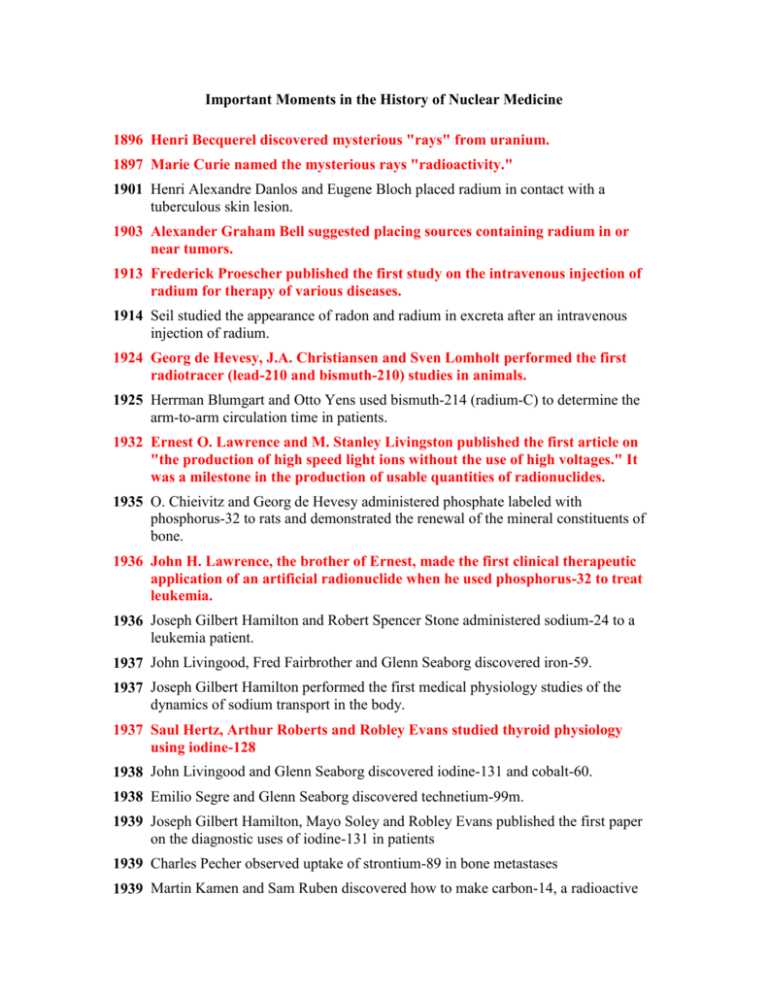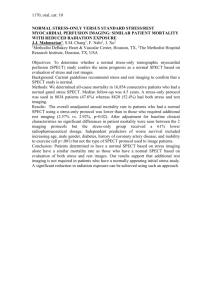Important Moments in the History of Nuclear Medicine
advertisement

Important Moments in the History of Nuclear Medicine 1896 Henri Becquerel discovered mysterious "rays" from uranium. 1897 Marie Curie named the mysterious rays "radioactivity." 1901 Henri Alexandre Danlos and Eugene Bloch placed radium in contact with a tuberculous skin lesion. 1903 Alexander Graham Bell suggested placing sources containing radium in or near tumors. 1913 Frederick Proescher published the first study on the intravenous injection of radium for therapy of various diseases. 1914 Seil studied the appearance of radon and radium in excreta after an intravenous injection of radium. 1924 Georg de Hevesy, J.A. Christiansen and Sven Lomholt performed the first radiotracer (lead-210 and bismuth-210) studies in animals. 1925 Herrman Blumgart and Otto Yens used bismuth-214 (radium-C) to determine the arm-to-arm circulation time in patients. 1932 Ernest O. Lawrence and M. Stanley Livingston published the first article on "the production of high speed light ions without the use of high voltages." It was a milestone in the production of usable quantities of radionuclides. 1935 O. Chieivitz and Georg de Hevesy administered phosphate labeled with phosphorus-32 to rats and demonstrated the renewal of the mineral constituents of bone. 1936 John H. Lawrence, the brother of Ernest, made the first clinical therapeutic application of an artificial radionuclide when he used phosphorus-32 to treat leukemia. 1936 Joseph Gilbert Hamilton and Robert Spencer Stone administered sodium-24 to a leukemia patient. 1937 John Livingood, Fred Fairbrother and Glenn Seaborg discovered iron-59. 1937 Joseph Gilbert Hamilton performed the first medical physiology studies of the dynamics of sodium transport in the body. 1937 Saul Hertz, Arthur Roberts and Robley Evans studied thyroid physiology using iodine-128 1938 John Livingood and Glenn Seaborg discovered iodine-131 and cobalt-60. 1938 Emilio Segre and Glenn Seaborg discovered technetium-99m. 1939 Joseph Gilbert Hamilton, Mayo Soley and Robley Evans published the first paper on the diagnostic uses of iodine-131 in patients 1939 Charles Pecher observed uptake of strontium-89 in bone metastases 1939 Martin Kamen and Sam Ruben discovered how to make carbon-14, a radioactive tracer widely used in medical and drug research. 1940 The Rockefeller Foundation funded the first cyclotron dedicated for biomedical radioisotope production at Washington University in St. Louis. 1941 Saul Hertz gave a patient the first therapeutic dose of iodine-130. 1942 Enrico Fermi and his associates demonstrated the first controlled chain reaction under the bleachers at Stagg Field at the University of Chicago. 1946 Allen Reid and Albert Keston discovered iodine-125, which became important in the field of radioimmunoassay. 1946 Samuel M. Seidlin, Leo D. Marinelli and Eleanor Oshry treated a patient with thyroid cancer with iodine-131, an "atomic cocktail." 1947 Benedict Cassen used radioiodine to determine whether a thyroid nodule accumulates iodine, helping to differentiate benign from malignant nodules. 1947 George Moore used iodine-131 labeled diiodofluorescein to "probe" the brain for tumors at surgery. 1948 Abbott Laboratories began distribution of radioistopes. 1949 B. Selverstone used phosphorus-32 to detect brain tumors at surgery with a probe detector. 1950 K.R. Crispell and John P. Storaasli used iodine-131 labeled human serum albumin (RISA) for imaging the blood pool within the heart. 1950 Abbott Laboratories sold the first commercial radiopharmaceutical, iodine131 human serum albumin (RISA). 1951 The U.S. Food and Drug Administration (FDA) approved sodium iodide 1-131 for use with thyroid patients. It was the first FDA-approved radiopharmaceutical. 1951 Benedict Cassen, Lawrence Curtis, Clifton Reed and Raymond Libby automated a scintillation detector to "scan" the distribution of radioiodine within the thyroid gland. 1953 Gordon Brownell and H.H. Sweet built a positron detector based on the detection of annihilation photons by means of coincidence counting. 1953 Robert F. Schilling invented a test of vitamin B-12 absorption, which plays a key role in nuclear hematology. 1954 David Kuhl invented a photorecording system for radionuclide scanning. This development moved nuclear medicine further in the direction of radiology. 1955 Rex Huff measured the cardiac output in man using iodine-131 human serum albumin. 1955 George V. Taplin used iodine-131 labeled rose bengal to image the liver. He also used radioiodinated hippuran to measure kidney function with scintillation detectors. 1957 W.D. Tucker's group at the Brookhaven National Laboratory invented the iodine-132 and technetium-99m generator, making these short-lived radionuclides available at distant sites from the production of the parent radionuclides. 1957 H. Knipping used xenon-133 to measure lung ventilation. 1958 Hal Anger invented the "scintillation camera," an imaging device that made it possible to conduct dynamic studies. 1959 Solomon Berson and Rosalyn Yalow invented the technique of radioimmunoassay to detect insulin antibodies in human serum. 1959 Picker X-Ray Company delivered the first 3-inch rectilinear scanner. 1960 Louis G. Stang, Jr., and Powell (Jim) Richards advertised technetium-99m and other generators for sale by Brookhaven National Laboratory. Technetium-99m had not yet been used in nuclear medicine. 1960 John McAfee and Henry Wagner imaged the kidneys with radiomercury labeled chlormerodrin. 1961 Allis-Chalmers installed the first U.S. "medical center" cyclotron at Washington University Medical School. The cyclotron was designed by M.M. Ter-Pogossian. 1962 David Kuhl introduced emission reconstruction tomography. This method later became known as SPECT and PET. It was extended in radiology to transmission X-ray scanning, known as CT. 1962 John Kuranz, Nuclear Chicago, delivered the first commercial Anger camera to William Myers at Ohio State University. 1963 The FDA exempted the "new drug" requirements for radiopharmaceuticals regulated by the Atomic Energy Commission. 1963 Henry Wagner first used radiolabeled albumin aggregates for imaging lung perfusion in normal persons and patients with pulmonary embolism. 1963 George V. Taplin developed albumin aggregates for study of phagocytosis by the reticuloendothelial system. 1963 B. Ansell and B.M. Cook used radiolabeled colloids for radiation synovectomy. 1964 The FDA exempted the "new drug" requirements for radiopharmaceuticals regulated by the Atomic Energy Commission. 1964 Paul Harper and Katherine Lathrup developed radiotracers labeled with Tc99m for the study of brain, thyroid and liver. 1964 Amersham marketed the first commercial radioimmunoassay kit (iodine-125 insulin kit). 1968 Henry Wagner and colleagues used xenon-133 ventilation scans to diagnose pulmonary embolism. 1969 C.L. Edwards reported the accumulation of gallium-67 in cancer. 1970 W. Eckelman and P. Richards developed Tc-99m "instant kit" radiopharmaceuticals. The first one was Tc-99m-DTPA. 1970 The FDA announced that it would gradually withdraw the exemption granted to radiopharmaceuticals and start regulating them as drugs. The change would be completed by January 20, 1977. 1971 The American Medical Association officially recognized nuclear medicine as a medical speciality. 1971 Gopal Subramanian and John McAfee introduced Tc-99m labeled phosphates for bone imaging. 1972 David Kuhl performed the first quantitative measurement of cerebral blood volume in living patients. 1973 H. William Strauss introduced the exercise stress-test myocardial scan. 1973 Elliot Lebowitz introduced thallium-201 for myocardial perfusion imaging, first proposed by Kawana. 1973 David Goldenberg demonstrated that radiolabeled antibodies against a human tumor antigen (CEA) could target and image human tumors in animals. 1976 John Keyes developed the first general purpose single photo emission computed tomography (SPECT) camera. Ronald Jaszczak developed the first dedicated head SPECT camera. 1976 N. Firusian used strontium-89 to reduce pain from metastatic bone disease. 1976 Ronald Jaszczak developed the first dedicated head SPECT camera. 1977 The FDA required manufacturers to obtain an approved new drug application for new and existing radiopharmaceuticals. The requirements are essentially the same as those for other prescription drugs. 1977 New England Nuclear received FDA approval to distribute thallium-201 for myocardial perfusion and the diagnosis and location of myocardial infarction. 1978 David Goldenberg used radiolabeled antibodies to image tumors in humans. 1981 J.P. Mach used radiolabeled monoclonal antibodies for tumor imaging. 1981 K.A. Krohn, D.R. Vera and S.M. Steffen developed the first Tc-99m labeled receptor ligand. 1982 Steve Larson and Jeff Carrasquillo treated cancer patients with malignant melanoma using iodine-131 labeled monoclonal antibodies. 1983 William Eckelman and Richard Reba carried out the first successful SPECT imaging of a neuroreceptor in humans. 1983 Henry Wagner carried out the first successful PET imaging of a neuroreceptor using himself as the experimental subject. 1987 Medi-Physics received FDA approval to market the first brain perfusion imaging radiopharmaceutical, iodine-123 IMP. 1988 The first Tc-99m brain perfusion radiopharmaceutical, introduced by Amersham, was approved by the FDA for the diagnosis of stroke. 1989 The FDA approved the first positron radiopharmaceutical (rubidium-82) for myocardial perfusion imaging. 1990 Steve Lamberts and Eric Krenning imaged endocrine tumors with somatostatin receptor-binding radiotracers. 1990 Loyola University Nuclear Information System (LUNIS), the first educational worldwide interactive computer network for nuclear medicine, went on line. 1990 Alan Fischman used indium-111 labeled chemotactic peptides to detect foci of infection. 1992 The FDA approved the first monoclonal antibody radiopharmaceutical for tumor imaging. 1993 Medi-Physics/Amersham received FDA approval to market strontium-89 chloride for relief of bone pain. 1994 Mallinckrodt received FDA approval to market the first peptide radiopharmaceutical that binds somatostatin receptors for imaging granulomatous and autoimmune diseases. 1995 ADAC Laboratories shipped the first SPECT camera to offer coincidence detection capable of FDG/PET imaging. 1996 “Legitimacy” of brain PET 1997 Validation of 123I-beta-CIT in assessing dopamine transporters in the diagnosis of Parkinson’s disease. 1998 FDG PET studies were used to assess the response of an initial dose of chemotherapy to predict the response to subsequent high-dose chemotherapy. 1999 Sentinel node studies approved by HCFA for improved diagnosis and management of cancers. 2000 Time Magazine recognizes Siemens Biograph as the invention of the year. 2001 16.9 million nuclear medicine procedures were performed in the United States. 2002 Formation of the National Institute for Biomedical Imaging and Bioengineering in the National Institutes of Health.







